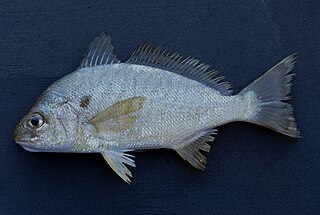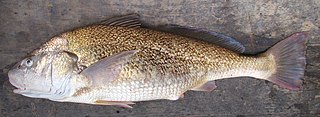
The spot, also known commonly as the spot croaker, Norfolk spot and the Virginia spot, is a species of small short-lived saltwater fish in the family Sciaenidae. The species inhabits estuary and coastal waters from Massachusetts to Texas, and derives its name from the prominent dark spot behind each gill. It is the only species in the genus Leiostomus. Spot are frequently caught by recreational anglers and are good to eat.

Bairdiella chrysoura, the American silver perch, silver croaker or goldtail croaker, is a species of marine ray-finned fish belonging to the family Sciaenidae, the drums and croakers. This species is widespread along the eastern cost of North America and is commonly caught by inshore anglers in search of larger species. This fish is common up to 20 cm (7.9 in), but can be found uncommonly to 30 cm (12 in).
The striped croaker, also known as the St Lucian corvina, is a species of marine ray-finned fish belonging to the family Sciaenidae, the drums and croakers. This species is found in the western Atlantic Ocean in the Caribbean Sea and Gulf of Mexico.

Cynoscion is a genus of marine ray-finned fishes belonging to the family, Sciaenidae, the drums and croakers. These fishes are found off the coasts of North and South America in the western Atlantic and eastern Pacific Oceans. Many fishes in this genus have been given the common name weakfish.

Cynoscion arenarius, sand seatrout, sand weakfish or white trout, is a species of marine ray-finned fish belonging to the family Sciaenidae, the drums and croakers. It is found in the western Atlantic Ocean. It is closely related to the common weakfish and may be a subspecies of C. regalis.

Boesemania is a monospecific genus of freshwater fish in the family Sciaenidae. This genus contains the single species Boesemania microlepis. Also known as the Boeseman croaker and smallscale croaker, this fish lives in southeast Asian rivers.

Reeve's croaker, also known as the goldbelly croaker, golden corvina, yellowfin croaker or yellowfin corvina, is a species of marine ray-finned fish belonging to the family Sciaenidae, the drums and croakers. This species is found in the coastal waters of the Indo-Pacific region. It is the only species in the monospecific genus Chrysochir.

Atractoscion is a genus of marine ray-finned fished belonging to the family Sciaenidae, the drums and croakers. The fishes in this genus are found in the Atlantic, Indian and Pacific Oceans.

Odontoscion dentex, the reef croaker or brown large-eyed croaker, is a species of marine ray-finned fish belonging to the family Sciaenidae, the drums and croakers. It is found in coral and rocky reefs of the tropical Western Atlantic, living as solitary individuals or in small groups at a depth of 1 to 30 m. This species feeds on small fish, shrimp, and larvae.
The prickly croaker is a species of marine ray-finned fish belonging to the family Sciaenidae, the drums and croakers. The species is found in the Indo-West Pacific around southeast Asia. It is the only species in the monospecific genus Aspericorvina.
Atractoscion atelodus, the small lunate caudal fin croaker, teraglin, Jew, teraglin-Jew, trag or trag-Jew, is a species of marine ray-finned fish belonging to the family Sciaenidae, the drums and croakers. This species is endemic to the eastern coast of Australia.
The yellowtail croaker, also known as the yellowtail jewfish, is a species of marine ray-finned fish belonging to the family Sciaenidae, the drums and croakers. This species is found in the southwestern Pacific Ocean off northern Australia and southern New Guinea. It is the only species in the monospecific genus Austronibea.
The bluestreak drum, also known as the bluish croaker, is a species of marine ray-finned fish belonging to the family Sciaenidae, the drums and croakers. It is the only species in the monospecific genus Elattarchus. This species is found in the central eastern Pacific Ocean along the coasts of the Americas.

Isopisthus is a genus of marine ray-finned fishes belonging to the family Sciaenidae, the drums and croakers. These fishes are found in the western Atlantic and eastern Pacific Oceans.

Johnius dussumieri, the sin croaker, Dussumier's croaker, Dussumier's silver jewfish, sharptooth hammer croaker or whiskered croaker, is a marine ray-finned fish belonging to the family Sciaenidae, the drums and croakers. This fish is found in the Indian Ocean.

Johnius carutta, the karut croaker or purple jewfish, is a species of marine ray-finned fish belonging to the family Sciaenidae, the drums and croakers. This species is found in the western Indian Ocean.

Macrodon is a genus of marine ray-finned fishes belonging to the family Sciaenidae, the drums and croakers. These fishes are found in the eastern Pacific and western Atlantic Oceans.

Micropogonias furnieri, the whitemouth croaker, golden croaker, hardhead, mangrove snapper, rocandoronco, two-belly bashaw, West Indian croaker, West Indian drum or whitemouth drummer, is a species of marine ray-finned fish belonging to the family Sciaenidae, the drums and croakers. This fish is found in the western Atlantic Ocean.

Odontoscion is a genus of marine ray-finned fish belonging to the family Sciaenidae, the croakers and drums. These fishes are found in the Western Atlantic and Eastern Pacific Oceans.

The half-mourning croaker is a species of marine ray-finned fish belonging to the family Sciaenidae, the drums and croakers. It is the only species in the monospecific genus Paranibea. This fish is found in the Indo-Pacific region.














